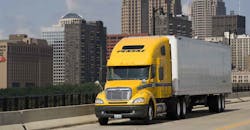Parcel shipping is expected to grow 20% in the next two years, based on 2017 e-commerce sales data. E-commerce compound annual growth rate (CAGR) could more than double goods deliveries in five years, doubling delivery trips in cities and doubling the demand for loading and unloading spaces.
Increasing growth of e-commerce is drastically affecting metropolitan areas, explained Anne Goodchild, PhD, director of supply chain transportation and logistics center at the University of Washington, during Fleet Owner’s August 16 webinar sponsored by Omnitracs. She was joined by Mike Becker, director of routing intelligence transformation at PepsiCo, who added thoughts on routing deliveries.
How will the shipping industry be able to handle this increase, especially in metropolitan regions?
Enter the Urban Freight Lab. Based at the University of Washington, Seattle, in partnership with the Seattle Department of Transportation, this living laboratory creates potential solutions that are generated, evaluated, and pilot-tested inside urban towers and on city streets. Clients of this lab include Ford Motor Company, Nordstrom, UPS, and USPS, just to name a few.
The Urban Freight Lab created a study regarding the final 50 ft. of a delivery: from the parking in a load/unload space, whether it is a curb, sidewalk, or intersection and ending inside an urban tower when they complete their deliveries. However, one development in the past decade has provided curbside delivery with a setback.
“At the same time that we are seeing this growth in delivery, we are also seeing other changes that are affecting street use and curb use,” Goodchild said. “One of those is on-demand passenger services like Uber and Lyft, which change the requirement for passenger travel from parking to load and unload at the curb. In 2017, more than 23 million people took a Lyft; that was essentially twice as many as the previous year, and Uber, which has a much larger share, completed 4 billion rides.”
Despite this competition for curb space, the research goals of the Urban Freight Lab focus around reducing dwell time and failed first deliveries for drivers. By decreasing dwell time, it can be argued that this can lower cost for delivery firms and their customers as well as bring more efficient use of truck load/ unload spaces and making room for other vehicles on the road. By reducing failed first deliveries, urban online shoppers can have a better experience while also lowering traffic congestion in the cities by avoiding multiple trips for the same deliveries.
The Urban Freight Lab suggests two steps to tackle meeting the increasing e-commerce demand. Step one involves mapping and measuring the complete truck load/unload space network throughout the entire metropolitan area, which includes curb parking spaces, alleys, and private loading bays and docks. By following this step, cities can fully educate themselves on the challenges that drivers are facing on the streets.
PepsiCo’s Becker noted the importance of recognizing left and right-hand turns when building a route. “Taking left-hand turns in a commercial vehicle tends to have more accidents instead of having a right-hand turn scenario,” Becker said. This safety measure can potentially maximize time efficiency as well as safety due to a left-hand turn penalty, he added.
Step two introduces some potential solutions: requiring developers to provide loading bays in every new building, using integrated technologies to actively manage, and increase the productivity of all load/ unload spaces in the city’s network as well as installing Common Carrier Locker Systems, which are mini-distribution nodes in buildings to gain delivery density.
The Urban Freight Lab tested this theory of Common Carrier Locker Systems in the Seattle Municipal Tower, hoping to develop a functional business model in public spaces that any retailer, goods delivery system, and user may access. With a 2.6-minute walk from loading bay to locker, 0.6-minute time to load the locker, and a 2.4-minute walk back to the loading bay, this test resulted in a 78% reduction in total delivery time.
With these and other potential solutions, the rising e-commerce rates and shipping demand may have met their match.
About the Author
Catharine Conway
Digital Editor
Catharine Conway is a past FleetOwner digital editor who wrote for the publication from 2018 to 2022.

